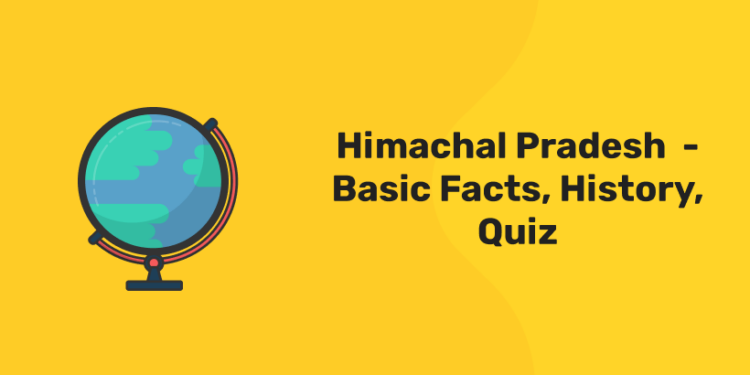Table of Contents
Himachal Pradesh is a state in India’s northwestern region. Himachal Pradesh is known for its natural beauty, hill stations, and temples, among other things. In the state, many perennial rivers run, and numerous hydroelectric projects have been established. The state’s economy is based on hydroelectric power projects, tourism, and agriculture. The history of Himachal Pradesh may be traced back to the Indus Valley Civilization, which existed between 2250 and 1750 BCE. The Koili, Hali, Dagi, Dhaugri, Dasa, Khasa, Kinnar, and Kirat were among the prehistoric tribes who lived in the area. Various kingdoms controlled Himachal Pradesh in the past, including the Delhi Sultanate, Rajputs, Mughals, Kingdom of Gorkha, British, and others.
The main source of revenue is tourism. The hilly state attracts travellers from all over the world due to its diverse and magnificent Himalayan vistas. Many notable pilgrimage locations with prominent Hindu temples may be found throughout the state. Handicrafts are well-known in Himachal Pradesh. Carpets, leather crafts, shawls, Kangra paintings, Chamba rumals, metalware, woodwork, and paintings are all worth seeing.
History of Himachal Pradesh
The history of this mountainous state is difficult and divided. Several so-called Aryan clans moved into the more fertile regions during the Vedic period (c. 1500 to 500 BCE) and assimilated the pre-Aryan population. Later Indian empires, such as the Mauryan (c. 321–185 BCE), Gupta (c. 320–540 CE), and Mughal (1526–1761), all of which arose in the Indo-Gangetic Plain, attempted to exert varying degrees of control over trade and pilgrimage routes into the region, as well as across the Himalayas between India and Tibet.
From the decline of the Mughal Empire (about the mid-18th century) until the early 1840s, when it temporarily came under Sikh sovereignty, Ladakh governed the remote, largely Buddhist area that is now the province of Lahaul and Spiti. During this time, fighting semiautonomous petty lords in various parts of modern-day Himachal Pradesh controlled trade routes as well as desirable agricultural and pastoral land. The British dominated this region for the next 100 years, either directly or indirectly, following the Sikh Wars of the 1840s.
Around the time of Indian independence in 1947, there was a public push to end feudalism in the region, and the princely state of Suket virtually surrendered to peaceful demonstrators. Himachal Pradesh was later designated as a province in 1948. It consisted of 30 princely states and was administered by a chief commissioner who represented the Indian government.
Between 1948 and 1971, when it became a state, Himachal Pradesh witnessed major changes in size and administrative structure. It was designated as a substate by the Indian constitution of 1950. It became a union territory in 1956 after merging with Bilaspur (a former Indian state that later became a chief commissioner’s province). Himachal Pradesh was formed in 1966 when numerous Punjab hill areas were merged and absorbed, including the areas around Shimla, Kangra, and Kullu; the district of Lahaul and Spiti; and portions of the districts of Ambala, Hoshiarpur, and Gurdaspur. In early 1971, Himachal Pradesh became India’s 18th state, and Y.S. Parmar, who had been a leader in the state’s fight for self-government since the 1940s, was elected as its first chief minister.
Attempt free GK Quiz! Download Entri App!
Interesting Facts about Himachal Pradesh
1: Who was the first woman President of India?
Himachal Pradesh (meaning “Snow-covered Region”) is a North Indian state that is part of the Punjab region. It is bordered on the north by Jammu and Kashmir, on the west by Punjab, on the south-west by Haryana, on the south-east by Uttarakhand, and on the east by the Tibet Autonomous Region.
Himachal Pradesh’s official language and lingua franca is Hindi. (A lingua franca is a language or method of communication used between people who do not speak each other’s native language.) In ordinary discourse, however, the majority of the people speaks Pahari, which includes practically all Western Pahari dialects. In HP, there are a total of 0032 languages.
- On April 15, 1948, the Chief Commissioner’s province of H.P. was established.
- With the implementation of the Indian Constitution on January 26, 1950, H.P. became a part C state.
- On July 1, 1954, Bilaspur was amalgamated with Himachal Pradesh.
- On November 1, 1956, Himachal Pradesh became a Union Territory.
- On November 1, 1966, Kangra and most of the other hill parts of Punjab were combined with H.P., but its status remained as a Union Territory.
- The State of Himachal Pradesh Act was enacted by Parliament on December 18, 1970, and the new state was established on January 25, 1971. As a result, H.P. became the Indian Union’s eighteenth state.
- Since then, Himachal Pradesh has gone a long way. It has had a succession of full-fledged governments that have brought the country to economic self-sufficiency.
Himachal Pradesh’s State Symbols
| State animal | Snow leopard (Uncia uncia) |
| State bird | Western Tragopan (Tragopan melanocephalus) |
| State Dance | Naati |
| State flower | Pink rhododendron |
| State tree | Deodar cedar (Cedrus deodara) |
Himachal Pradesh Wildlife Sanctuaries
| District | Sanctuaries |
| Kullu | Sachu Tuan Nala
Gamgul Tundah Kugti Kalatop – Khajjiar. |
| Kangra | Maharana Pratap Sagar (Pong Dam Lake)
Dhauladhar. |
| Kullu | Manali
Kias Khokhan Kanawar Tirthan Sainj Great Himalayan National Park. |
| Mandi | Nargu
Shikari Devi Bandli. |
| Bilaspur | Gobind Sagar
Sri Naina Devi Ji. |
| Shimla | Shimla Water Catchment Area
Talra Daranghali. |
| Solan | Majathal
Darlaghat Shilli. |
| Kinnaaur | Sangla
Lippa Asrang Rupl Bhaba. |
| Sirmaur | Renuka
Simbalbara Churdhar. |
| Lahul Spiti | Pin Valley National Park. |
Free UPSKILLING Courses!
Take your first step toward mastering in-demand skills, acing interviews, and securing top-tier jobs with Entri's free upskilling courses.
Start Learning!Festivals of Himachal Pradesh
Halda festival – Invite the New Year
Himachal Pradesh’s Halda Festival Halda festival, dedicated to the goddess of wealth, Shashikar Apa, is celebrated with great passion and enthusiasm to usher in the new year. The Lamas decide on the exact date of the celebration. People from Lahaul districts came together to celebrate the new year by performing music.
Lamas also select a different location to carry out a traditional rite in which each household brings a few cedar tree branches to burn in a bonfire. The community’s oneness is symbolised by the campfire. It is significantly more popular in the Keylong, River Chandra, and River Bhaga valleys.
Chet Festival
(Dholru) is the first lunar month, and the first day of the month is commemorated with the hope of bringing happiness and wealth. In Kullu, this celebration is known as Chatrali, and in Bharmaur, it is known as Dholru. The first day of Chet month is particularly significant in Kangra, Hamirpur, and Bilaspur.
Navratras
In Himachal Pradesh, the Navratras are celebrated with great enthusiasm. Durga Ashtami is a very important festival in the state. During the Navratras, people go to the nearest Durga temple to pray.
Baisakhi
Bisowa is the Kangra name, Bissue is the Shimla name, and Lisshoo is the Pangi-Chamba name. This festival is traditionally held on April 13th. The festival preparations begin months in advance. The houses have been washed in white. At Haridwar, Tattapani near Shimla, Banganga near Kangra, and Markanda near Bilaspur, people take sacred baths. Baisakhi fairs are hosted throughout the day in numerous locations, with characteristic gaiety and attractiveness. Women’s engagement in huge numbers adds a distinctive dimension to the people’s joyous mood.
Haryali
In Lahaul, it’s known as Shegtsum, and in Jubbal, it’s known as Dhakhrain. In Kinnaur, it’s known as Kinnaur. This festival is held on the Ist Sawan, which is July 16th. A few days before the celebration, any household near the house divine beings plants seeds of five to seven types of grains together in a tiny basket full of earth. Stems are placed on the upper frame of the entrance and offered to household divine entities. On this specific day, farmers do not yoke cattle. Cowdung balls are used to shed blood sucking insects such as lice, pests, and flees. Wild flowers are used to adorn the town deity in Kinnaur district. Throughout the festival, dancing and singing are commonplace.
Kullu Dussehra
Dussehra in Kullu Himachal Pradesh is a state in northern India. The Dussehra celebrations in Kullu are unlike those in other parts of the country since no porcelain figurines of Ravan or Kumbhkarna are burned. The traditional Kullu Dussehra is held in October and begins with Lord Raghunathji’s ceremonial procession. The Kullu Raja and other town holy beings lead the Rath Yatra of Lord Raghunathji’s idol, which is also known as the Gods’ Run. Lord Raghunathji, seated in a colourful chariot, is hauled across the Maiden by large ropes from his fixed location in Dhalpur Maidan.
Phulech
Only in the Kinnaur region, in the month of Bhadon or the beginning of Asauj, is this festival observed. People from each home go to the hilltops to collect flowers, which are then given to the village divine being and then dispersed among the people. Priest makes predictions about harvests, as well as seasonal changes and other factors.
Himachal Pradesh General Knowledge Quiz
Q.1.The longest river of Himachal Pradesh is
Ans: Satluj
Q.2.The Chail cricket stadium is located in which district of Himachal Pradesh?
Ans: Solan
Q.3.Which one is is the largest district by area wise in Himachal Pradesh
Ans: Lahaul and Spiti
Q.4.Who was the leader of Dhami movement in Himachal Pradesh?
Ans: Bhagmal Sautha
Q.5.Which of the following district of Himachal Pradesh is known as “Chhota Kashi”?
Ans: Mandi
Q.6.What is the State Tree of Himachal Pradesh?
Ans: Deodar cedar
Q.7.How many districts are in Himachal Pradesh?
Ans: 12 Districts
Q.8.Chamunda temple located in which district?
Ans: Chamba
Q.9.Which District is Bhuntar Airport located in?
Ans: Kullu District
Q.10.When was Himachal Pradesh declared as a Union Territory?
Ans: 1 November 1956
Q.11.Which State is situated west of Himachal Pradesh?
Ans: Punjab
Q.12.Nati Dance belongs to which Indian state?
Ans: Himachal Pradesh
Q.13.Which is the Highest Peak of Himachal Pradesh?
Ans. Reo Purgyil (6816 m)
Q.14.When did Himachal Pradesh host Paragliding World Cup?
Ans: 2015
Q.15.Who was the first Chief Minister of Himachal Pradesh?
Ans: Yashwant Singh Parmar














